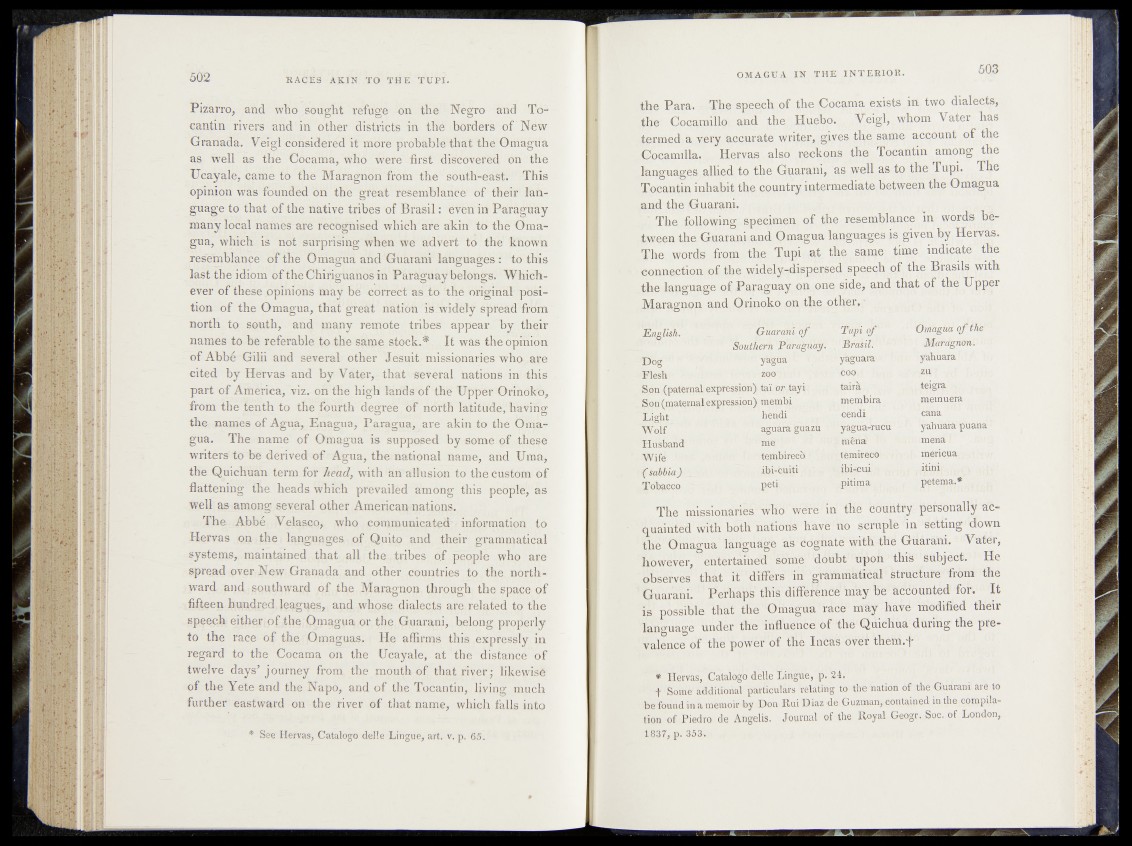
Pizarro, and who sought refugee on the Négro and Tocantin
rivers and in other districts in the borders of'New
Granada. Veigi considered it more probable that the Omagua
as well as the Cocama, wild Were first discovered On the
Ueayale, came to the Maragnon from the south-east. This
opinion was founded on the great resemblance of their language
to that of the native tribes of Brasil : even in Paraguay
many local names are recognised which are akin to the Omagua,
which is not surprising when we advert to the known
resemblance of the Omagua and Guarani languages : to this
last the idiom of ihe Chiriguahos in Pâfàguay belongs. Whichever
of these ^opinions may Be correct as to ‘the original pöst-
tion of the Omagua, that great natiófi is widdïy é^rèàd from
north to south, and many remote tribes appear by their
names to be referable to the same stock.* It was the opinion
of Abbé Gilii and several other Jesuit missionaries^Who^are
cited by Ilervas and by Vater, that several nations in this
part of America, viz. oh the high lands of the Upper Orinöko,
from the tenth to the fourth degree of north u - jhlThn /--r- latitude, havi■ nrOg
the names of Agua, Enagua, Paragua, are akin to the Omagua.
The name of Omagua is supposed by some pf these
writers to be derived of Agua, the national name, and Uma,
the Quichuan term for head, with an allusion to the custom of
flattening the heads which prevailed among this people, as
well as among several other Americannations.
The Abbé Velasqq, who. communicated'' information to
Hervas on the languages of Quito and their grammatical
systems,, maintained that all the.,tribes of people who are
spread over Mew Granada and other countries to the northward
and southward of the Maragnon through the space of
fifteen hundred. Içggtjes, anji whose dialects are. related to the
speech either , of the . Omagua or the Guarani, belong properly
to the race of the Omaguas. He affirms this expressly in
regard to the Cocama on the Ueayale, at the distance of
twelve days’ journey from the mouth of that river; likewise
of the Yete and the Napó, and of the Tocantin, living much
further eastward on the river of that name, which falls into
the Para-»,-The speech of the-jCocaw.a exists in two dialed^,
the Cocarpillo and 'th e Huefeo.,^ ; Yeigl,, whom Vater has
,tprmed a very accurate writer, ^iy^s t^e sa-me account of the
^ocamilla.,,, Hervas ^lsb.juckqns the Tocantin among the
.languages allied to the Giiarani, as well^as to the Tupi. The
Tocantin inhabit the country intermediate between the Omagua
and the Guarani. . , | j j | x . jjpj
The following specimen of the resemblance in words between
the Guarani and Omagua languages ja,given by,Hervas.
||Hie words from the Tupi{)^t s«^e Jime. indicate" ihe
connection of the w\dely-<dispersed spepch off the B,rasils jvith
the language of Paraguay qn on^ side, and that of the Up|>er
Maragnon and Orinoko ,on the others
English.
'Dog "
Flesh 1
B |
‘Wolf
Hüsband
Wife H
* fsabbia) 1
Tobacco
Guarani rbj irfu p i of'' ' "OiA agitâ o f tW ’x "
hern Paraguay? ’’*Pfasil. J -x ■ MarcfëntinU *•«
ykguara- ï^ h ù a rid d ..
200'; r ICoo.-i . ZIÏ | •
y ^ |p ^ ta y i |,;!. , teigrgi
)m,embi membirà memuera .
1hendi •èendi ' cank
’ aguata £ùazu ; ^ÿâgùh-Vu'Ca 'ÿkhiMtà'püariai
me ; mena . ? ; 'ïne'iad J
temhiffecif ; Tèmhacó' . ; i n^riçuas'-jÿ
jb^c jiih A >’ ibiceui • ^tiçir.j ;
peti pitima peterna.® ,
w h oW e r e r in th e c o u n try ! p eM ê n ttlly a è -
quainted with both natioris' havd'^id sGfUpld in 'Setting^ clown
5%e Omagua language as $dgWe With-fli^ Guarani. Vaifer,
however, entertained sofcnd ‘doubt !trj^on this subject.1 'Ho
' observes that it differs' in grammktifcaP krufetuf^from the
'Guarani. ' Perhaps this differonc,ditohy%h^^duntMs€ok; It
is hdSSiBle that the 'Omagua ‘racb mUy ha4«l modified their
language under the influ'dft^e' of the QilicHua during the pre-
WolpnoA nf the nower of tnd Ine^'-d^feT theUi.f
^ Hervas, Catalogo <Me’X.irigüfe,p:}24.’'‘ ' ’
•f’Soïhé' additional particulars relating to the nation of the Guarani-aie to
•be found in a memoir by .Don Rui Diaz .d«/Gu^many ^'ritajned! inthejcpmpila-
tion of Piedro de Angelis. Journal of the Royal Geogr. Soc. of London,
1837,